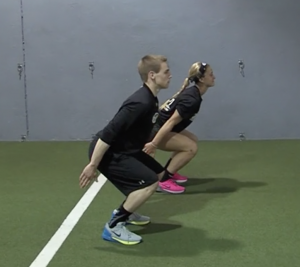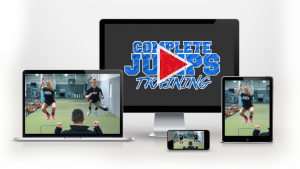By: Darin Jerome
In today’s age of sports when it comes to performing on the field, speed is king. We, as trainers, are trying to get our athletes bigger, stronger, and faster to achieve maximum results in competition. But in recent years, the rate of injuries seems to be on the rise and we may be partially at fault for these occurrences. All too often we are training our athletes with explosive movements to help with acceleration, focusing on these aspects to create a faster athlete. At the same time, we forget about an area of importance: deceleration and landing mechanics.
Teaching our athletes how to start and stop properly when accelerating, and changing directions, as well as how to jump and land correctly, helps not only to improve speed and agility, but will also significantly reduce the chance of injury.
For a FREE resource on coaching acceleration, get Coach Lee Taft’s Acceleration Checklist.
Incorporating deceleration and landing mechanics training in a properly balanced speed and agility program is all too often neglected or quite simply not used enough in training to help reduce injuries. Often, the primary goal of the athlete is to get faster in their sport and we focus mainly on concentric exercises to help with acceleration.
Biomechanically, proper deceleration occurs when our muscles eccentrically contract to help us come to a stop safely. Studies have shown that most injuries occur to our muscles during eccentric movements. Therein lies the importance of properly teaching our athletes to start and stop and jump and land correctly.
To properly teach deceleration and landing mechanics, we first must understand, biomechanically, how our body works during these movements. Deceleration causes a high neural demand that puts a lot of stress on our body with eccentric movements. Proper deceleration involves coordinating movements, such as bending at the hips, knees, and ankles while maintaining center of gravity.
Far too often, athletes come to us with bad habits for proper deceleration and landing mechanics or simply have had no training experience with this aspect of speed and agility training. A proper speed and agility program will incorporate these actions on a daily basis.
There are countless exercises you can do to teach deceleration and landing mechanics. For the purpose of this article, we will list two very basic exercises that will assist in improving your deceleration and jumping mechanics.
- Drop Squat: In a standing position, with feet shoulder width apart, the athlete will start with their arms erected straight up in the air and then proceed to slightly hop in place, lower their arms and land in a proper squat stance with proper hip, knee, and ankle alignment and a good center of mass. Once an athlete has mastered this technique we can get into more progressions such as single leg hops with mini hurdles.
- Sprint to Stop: Just how it sounds, start from a sprinting position and come to a controlled stop with a lower center of gravity and stable base. Initially start off with a short start and stop distance and progress to longer distances to have to start and stop when greater velocities are applied.
These basic exercises are a great way to implement safe and proper landing and deceleration techniques to help improve speed and agility for all types of athletes. Perform these types of exercises focused on deceleration and landing mechanics at least two times a week and you should see a formidable change in performance of your athletes, as well as helping to prevent any injuries that may occur.
About the Author
Darin Jerome, BS, CSAC, CWPC, USATF- Level 1 is the head sports performance coach at IMPACT Sports Performance in Boca Raton, FL. Originally from Aurora, IL, Darin Jerome has lived in South Florida for 10 years. Darin graduated from Eastern Illinois University earning a Bachelor of Science in 2008. He has been training for 10 years in South Florida coming from one of Illinois top sports performance centers, Velocity Sports. During Darin’s time at Velocity, he had the privilege of working with elite youth athletes, as well as nationally ranked football and volleyball athletes at the high school and Division-I Collegiate levels. Darin was able to excel training at all age groups, as he himself was a Division-I football athlete at Eastern Illinois University that went through elite training programs throughout his career. Darin attributes his success to the proper training regimens he was placed on that focused on maximizing movement-specific strength and game speed. While in South Florida, Darin has been specializing in developing speed and agility for athletes of all ages including many youth, high school, collegiate and professional athletes. He has worked with professional athletes from the NFL, NHL and MLB. He is currently one of the Head Strength & Conditioning Coaches for Lynn University’s Men’s and Women’s teams.
Recommended Athletes Acceleration Products
 | |
| Complete Speed Training |





0 Comments for “The Importance of Deceleration and Landing Mechanics”